I admit it: I have a particular fondness for Opus camper trailers. I also have a rather bitter taste in my mouth. The bitterness comes not from the design of these campers, with their distinctive dome-shaped tents, but from the fact my personal Opus was nicked from my driveway a couple of years ago.
My Opus was the first that the company had built in Australia. Previously, Opus campers were built in the UK. It wasn’t perfect but it was ours. Perhaps my personal connection to these campers makes me the wrong person to review the company’s latest, the Air Opus. But I prefer to believe that it makes me exactly the right person.
OPUS POTENTIAL
The potential for the Opus was evident from the earliest of models but, frankly, it always needed to be finessed. Spec-wise, it was pretty basic. However, hats off to this manufacturer for recognising all of this and taking on board customer feedback. The Opus is now a much more refined, considered camper trailer.
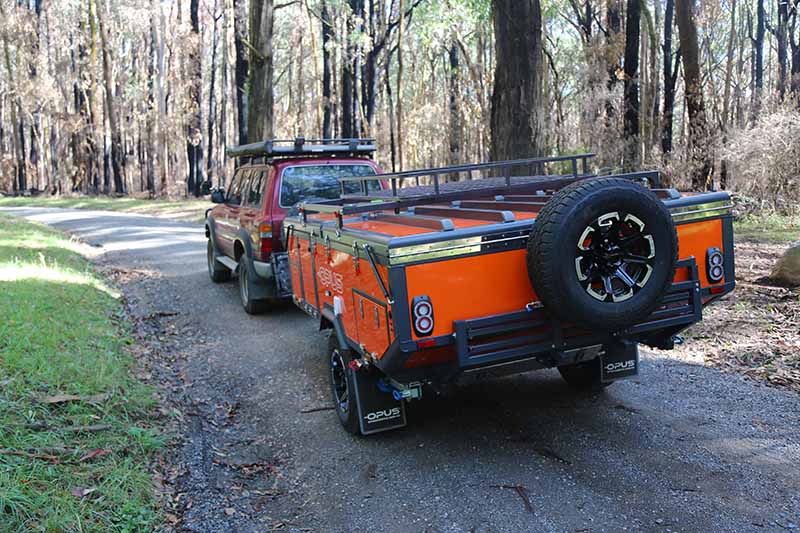 First, the Opus is available in a few variants. You’ve got the standard Opus, which has fold-out beds either end and is known as the 4 Sleeper, the Opus 2 Sleeper, which has a fold-out bed at the forward end only, and the subject of this review, the new Air Opus.
First, the Opus is available in a few variants. You’ve got the standard Opus, which has fold-out beds either end and is known as the 4 Sleeper, the Opus 2 Sleeper, which has a fold-out bed at the forward end only, and the subject of this review, the new Air Opus.
The principal difference between the standard Opus 4 Sleeper and Air Opus is in how the tent is deployed. The standard 4 Sleeper’s tent is supported by a number of aluminium ‘hoops’ that require manual fiddling, a process that takes a small amount of effort and time.
The Air Opus, however, will more or less self-deploy in about two minutes. How? It’s not quite magic but it sure takes the effort out of things. Simply push a button and the onboard air-compressor will inflate the so-called ‘air beams’, which replace the standard hoops, until they become rigid enough to hold the tent securely in place, even in a gale.
Just as with a bike or car tyre, the air beams can be punctured; however, the inner tube can be replaced. I liked the fact, too, that should a puncture occur when you’re on a trip, a series of valves will allow you to isolate the offending air beam and continue to use the camper, albeit with the tent a little out of shape.
Packing down the tent is just as quick, if not quicker. Simply open the five air beam valves on the camper’s offside and the tent will slowly collapse onto the trailer. Honestly, it’s about as effortless as it can get.
Now, it’s important to note that our review Air Opus was a prototype – production models will be available soon. So, therefore, there were a couple of niggles that are being ironed out as you read this. The check valve on the air-compressor leaked slightly and the base of one of the air beams had a habit of popping out of position. The reason for this is the tent for our prototype Air Opus was built on the body of a standard Opus but, as I said, these minor issues are being addressed. That aside, the air-beam system works a treat.
MOVING THE KITCHEN
The early-model Opus campers had a small onboard kitchen. When the camper was packed up, three kitchen modules had to be rested on the floor of the camper, leaving no space for other items, such as sleeping bags. For my family, that meant most things were stored in the tow vehicle.
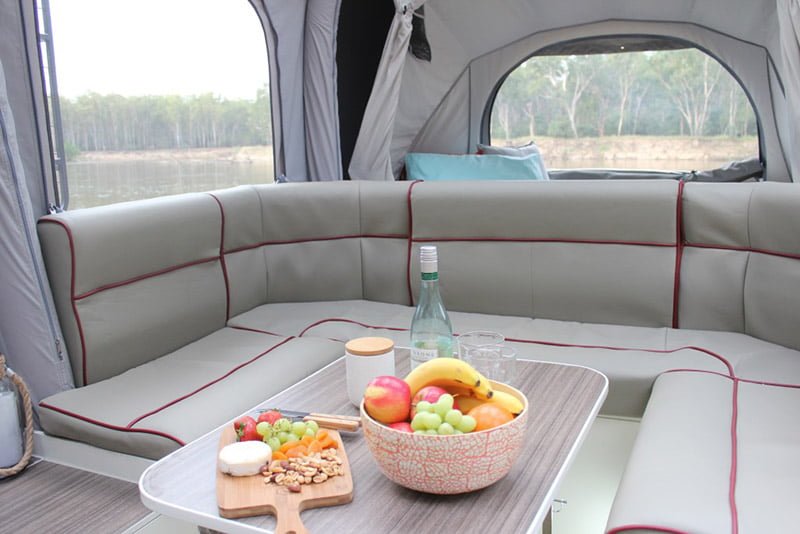 The new Opus, including the Air Opus, recognises this. The internal kitchen has been removed entirely, freeing up the offside in favour of storage space, and a slide-out stainless steel kitchen can be fitted to the nearside as part of the so-called Ready to Roll pack.
The new Opus, including the Air Opus, recognises this. The internal kitchen has been removed entirely, freeing up the offside in favour of storage space, and a slide-out stainless steel kitchen can be fitted to the nearside as part of the so-called Ready to Roll pack.
Another significant improvement to the Opus involves the forward bed. Previously, the bed stays – steel supports that you’d secure between the bed base and camper body – blocked access to the drawbar-mounted toolbox. Each time you wanted to get in there, you’d have to remove the bed support. Not any more. After much consideration, the Opus crew had a Eureka moment. The answer was there all along. Increasing the height of the toolbox and including a special support on the stoneguard protecting the 9kg gas cylinder, so that the bed base securely rested on both, eliminated the need for bed stays up front.
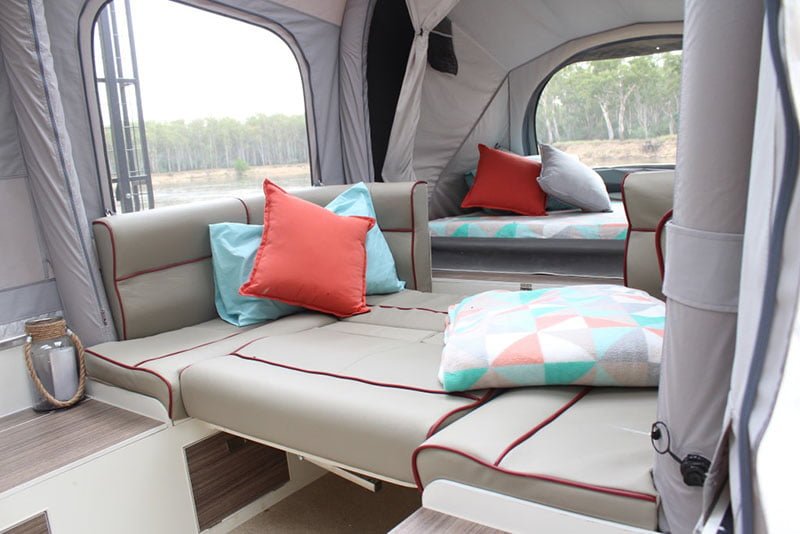
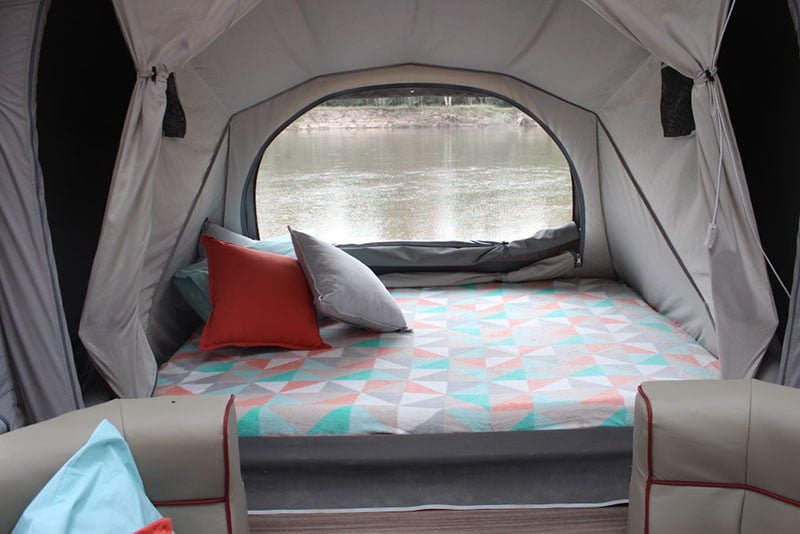 Electrically speaking, the Air Opus is much more sophisticated than its forebears, with isolating switches for items such as the fridge that you’d presumably fit to the tray in the toolbox, the air-compressor, and lights, etc.
Electrically speaking, the Air Opus is much more sophisticated than its forebears, with isolating switches for items such as the fridge that you’d presumably fit to the tray in the toolbox, the air-compressor, and lights, etc.
I also liked the addition of the spare wheel carrier, which drops down to make way for the rear bed to fold out.
Beneath the Opus you’ll find independent coil suspension and, overall, a neat finish to the wiring and plumbing. There are two 80L water tanks fitted – the second tank is part of the Ready to Roll pack – each protected by checkerplate. Up front, the Air Opus is fitted with a polyblock offroad coupling as standard. Personally, I find these couplings fiddly, especially when hitching up without a guide. I’d prefer a D035, which is available as an option. You’ll also find an Anderson plug, so you can charge the camper’s battery(s) with a portable solar panel or by the vehicle when towing.
STEP INSIDE
Inside, the Air Opus looks much the same as it did when my camper was stolen: two double beds, front and rear, a club lounge and a couple of storage spots by the entrance. The biggest change, as mentioned earlier, is the removal of the internal kitchen. Which, in my opinion, was the right move.
The dinette/lounge converts to an extra bed. Simply lower the portable table onto a couple of timber edges to form the base and insert the backrest cushions. When packing the camper away, those backrests need to be removed and assembled on top of and below the table.
Because the lounge spans the full width of the trailer, it’s necessary to climb over the cushions to get to the rear bed. Kids: remove your shoes! If I may be so bold, I’d suggest further iterations of the Air Opus include a layout option with a smaller dinette that allowed easy walk-up access to the rear bed.
The domed tent features four ‘skylights’ which, once unzipped, let in lots of natural light, but the best part is that the nearside wall can be unzipped and removed completely so you can well and truly enjoy the view. Oh, and if the camper feels a little flexible underfoot, that’s because it’s insulated under the vinyl.
READY TO ROLL
The Air Opus is at its best with the Ready to Roll pack fitted. It includes an Air annexe (a custom annexe system that utilises the same air beam system, which can hook into the camper’s air-compressor), a slide-out stainless steel kitchen, an additional 80L water tank and 100Ah AGM battery, the spare wheel and rear carrier, and ‘leather-type’ upholstery for the lounge.
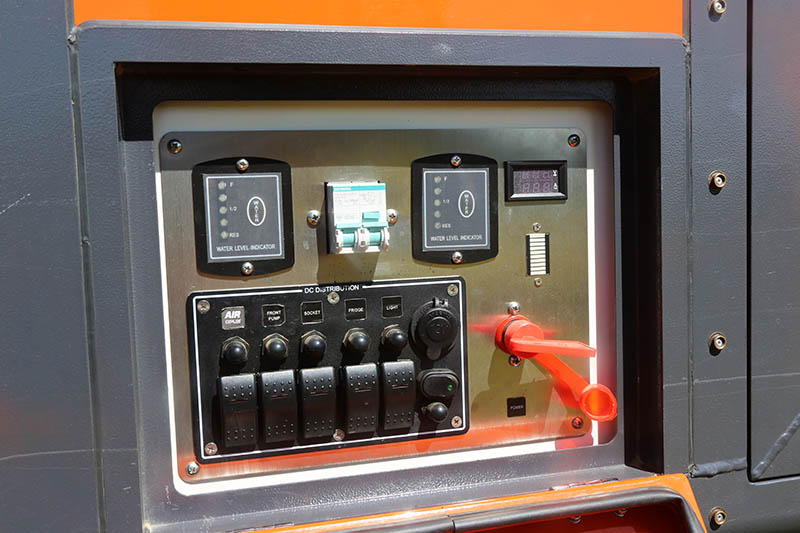
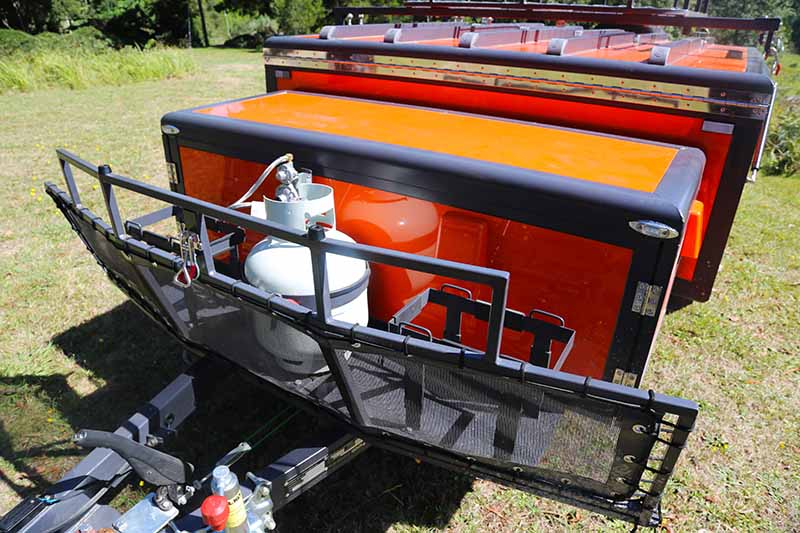 The slide-out kitchen can be bought separately as a $1500 option, should you not want to buy the entire Ready to Roll pack.
The slide-out kitchen can be bought separately as a $1500 option, should you not want to buy the entire Ready to Roll pack.
GORV’S VERDICT
The Opus, whether in Air, standard 4 Sleeper or 2 Sleeper format, has come a long way. It is now a more refined, elegant design. And you have to give credit where it’s due: the air beam system, which if I’m not mistaken is a first for an Australian camper trailer, works very well. The Air Opus is, effectively, a ‘pole-less’ camper that just about sets itself up. Press a button and let technology do the rest.
We’re looking forward to seeing the Air Opus once production models start rolling off the line. No doubt, with the aforementioned niggles fixed, it will be one attention-grabbing number.
THE SCORE
FIT AND FINISH – 
LAYOUT – 
INNOVATION – 
HITS & MISSES
- Air beam system and ease of use
- Continual development of the Opus
- That the air beams can be isolated should one be punctured
- Leaking air-compressor check valve (which will be fixed for production models)
- The base of one air beam kept popping out of position (again, this will be fixed for production models)
- We’d like to see the slide-out kitchen fitted as standard
COMPLETE SPECS
Overall length: 5.6m
Trailer width: 2.1m
Travel height: 1.45m
Tare: 1200kg
ATM: 1800kg
Unladen ball weight: 100kg
Trailer construction: Composite aluminium panels with steel frame
Canvas: 260gsm
Coupling: Offroad polyblock
Chassis: Galvanised steel
Suspension: Independent coil with dual shock absorbers per wheel
Brakes: 12in electric
Wheels: 15in alloy
Fresh water: 1x80L as standard; additional 80L water tank is optional
Awning: Canvas with optional Air Annexe
Battery: 2x100Ah AGM (second battery optional)
Solar: No
Gas cylinders: 1x9kg
Jerry cans: 2x20L
Sway control: No
Cooking: Optional external kitchen
Refrigeration: No. Slide-out tray for portable fridge provided.
Shower: External
Lighting: 12V
Hot water: No
Roof rack
Ready to Roll pack
$29,989; $28,990 with just the Ready to Roll pack (which includes the Air Annexe) fitted or $25,990 without (all prices exclude on-road costs)


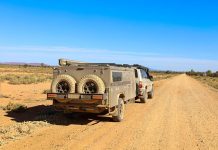

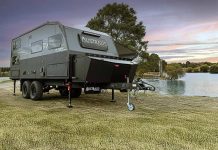

I would really love to see some photos of the 2 berth Air Opus camper but can’t seem to find any, Can any body tell me where to look, nothing on their site.
Same as Kathy, I would really like to see the 2 berth air opus, live n Werribee, if I come over to your showrooms on Monday, is there 1 to view? I like the setup of the 4 berth but seeing as it’s just me, that my be a little wasted space.
Been going around checking caravan, campers as I ready to buy but have concerns about the weight for a single person setup so your inflatable part really interesting.
Oh yeah best price for both please.
Great camper sure is on our bucket list sooner rather than later